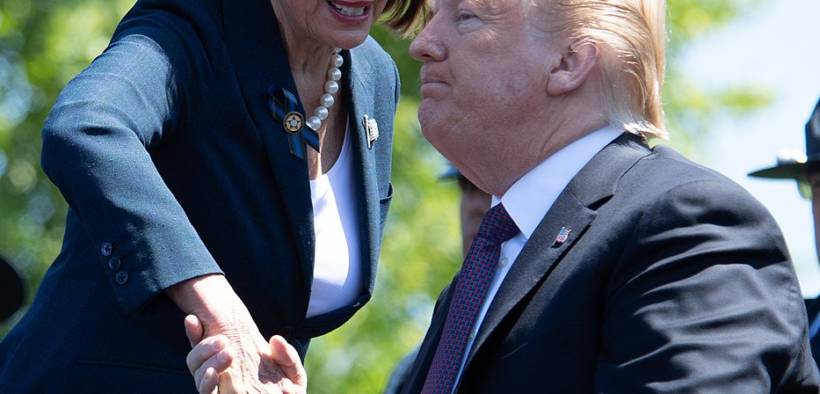Congress and Trump Ready for Next ‘Big & Bold’ Stimulus

The US Congress just passed a historic $2.2 trillion stimulus last week, but it is already looking ahead to the next stage of economic relief. When lawmakers negotiated the previous relief package, they said further measures may come down the pipe before the COVID-19 pandemic recedes. US President Donald Trump and Democrats in the House are both on the same page this time around with their focus on boosting infrastructure spending.
Bipartisan Agreement for Infrastructure Spending
“Our next bill will lean toward recovery, how we can create good-paying jobs as we go forward, perhaps building the infrastructure of America,” said Speaker of the House Nancy Pelosi, D–Cali. She specifically mentioned improvements to broadband internet access and water utilities as starting points for the next bill.
Trump apparently tuned into Pelosi’s interview on MSNBC’s “Morning Joe” on Monday. The president said aside from “her usual complaining that I’m a terrible person, she wasn’t bad.”
The comment was a different tone than his comment to “Fox & Friends” on Monday that Pelosi is “a sick puppy in my opinion. She’s got a lot of problems.” Moreover, the president echoed Pelosi’s call for the next stimulus bill to be focused on infrastructure spending.
“With interest rates for the United States being at ZERO, this is the time to do our decades long awaited Infrastructure Bill. It should be VERY BIG & BOLD, Two Trillion Dollars, and be focused solely on jobs and rebuilding the once great infrastructure of our Country! Phase 4,” Trump tweeted Tuesday.
Resurrecting a Campaign Promise
Both parties have found common ground with increasing infrastructure spending, but they have never managed to agree on how it will be funded. With the nation still muddling through the first weeks of COVID-19, Trump has determined now might be the perfect opportunity to circle back on his 2016 campaign promise of $1 trillion for infrastructure, according to Bloomberg.
Although the idea never came to fruition, Trump reiterated his calls for increased spending during his 2018 State of the Union address, with an increased price tag of $1.5 trillion. A month later, Trump told legislators he would support a 25-cent per-gallon gasoline tax increase. Democrats supported the idea, but were met with some resistance from Republicans.
However, this alone did not kill the proposal. Instead, Democrats continued meeting with the president until May 2019 when he demanded the put an end to their investigations of Trump’s alleged misconduct. Following the president’s threats that he would not make a deal until Democrats acquiesced, both sides quit discussing the infrastructure plan.
Now, it’s back on the table as the White House and Congress look ahead to a future free of COVID-19. Some Republicans, however, are reluctant to rush another large stimulus package through Congress. Senate Majority Leader Mitch McConnell, R–Ky., advocated for waiting to let the dust settle before making any decisions, The Hill reported. McConnell said part of the reason for delaying is to ensure any relief spending is focused solely on the crisis at hand.
“I’m not going to allow this to be an opportunity for the Democrats to achieve unrelated policy items that they would not otherwise be able to pass,” McConnell said.
Fourth Time’s a Charm
An infrastructure bill would be the fourth emergency spending measure authorized by Washington, CNBC reported. The first came on March 6 when Trump signed legislation for $8.3 billion for virus containment and vaccine research. Two weeks later, Washingtpon approved a $100 billion relief package for emergency paid leave and expansion to unemployment benefits. Both phases were ultimately dwarfed by the Coronavirus Aid, Relief, and Economic Security (CARES) Act.
A spending packaged dedicated to infrastructure could provide economic relief as well as provide a timely update to outdated systems. The World Economic Forum ranked the US as 13th in regard to infrastructure, according to Bloomberg, and the American Society of Civl Engineers projected a need for $2 trillion by 2025.
Trump said he would like to see the money go toward roads, bridges, railroads, and similar projects. It would not be the first time an economic stimulus project focused on such initiatives. In 1935, former President Franklin D. Roosevelt created the Works Progress Administration, which focused on the same goal of providing jobs while updating American infrastructure. The WPA cost $4.9 billion in its first year ($4.9 billion in 2020 after adjusting for inflation).
However, the WPA was created by executive order, not as a legislative relief package. Furthermore, the WPA hired workers directly. Neither Congress nor Trump have detailed how Phase 4 of the coronavirus relief will function, but if it is like the previous federal relief measures, it will be in the form of grants or loans to businesses and governments for infrastructure projects.















